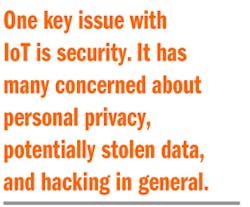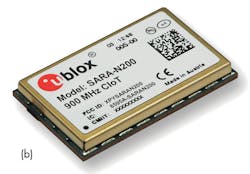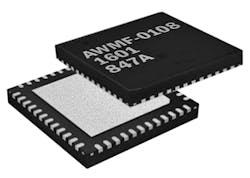This file type includes high resolution graphics and schematics when applicable.
Wireless is everywhere. In fact, there are probably very few times during the day when you are not using wireless. Think about it—smartphones, Wi-Fi, Bluetooth connectivity, GPS, AM/FM/satellite radio, garage door openers, automatic cruise control radar and more. And the future holds even more wireless for us all. Here is an overview of the current state of wireless and what you can expect in the future.
The Nascent Internet of Things
The Internet of Things (IoT) and its predecessor machine-to-machine (M2M) communications are probably the most discussed wireless applications today. While the IoT/M2M has been massively hyped, companies and other organizations are already making progress toward the predicted 50 billion connected devices by 2020. It is estimated that there are already over a billion devices adding to the already thick cloud of electromagnetic radiation that envelopes us all. Good examples are remotely controlled thermostats and home video monitoring with your smartphone. Sensor networks are also beginning to show up in manufacturing plants and factories, agriculture, smart cities, and the smart grid. Drones are IoT devices. Smart watches are IoT.
Multiple wireless technologies are being used to make all these connections. These include Wi-Fi, Bluetooth Low Energy, 802.15.4, and derivatives like ZigBee, Z-Wave, LoRa/LPWAN, and 3G/4G cellular. Even RFID and NFC are finding a place. No one technology seems to dominate. It is doubtful that any one technology will emerge as a dominant player, nor is it probably necessary. However, in some sectors such as industrial or smart cities, some say that standardization is essential. Multiple efforts are being made to identify what that standard may be. Some of the organizations currently involved in IoT standards development include IEEE, ETSI, IETF, ITU-T, ISO/IEC, oneM2M, 3GPP, and ISA. There are other cooperative efforts going on to further muddy the waters.
Part of the problem of defining an IoT standard is the incredibly broad scope of IoT applications. Some of the more prominent sectors include home network monitoring and control, industrial wireless sensor networks, smart grid, smart cities, personal area networks, wearables, automotive, medical, and cellular M2M. It is hard to imagine one global standard that can cover such a wide range. Perhaps there will be one major standard for each major sector.
Another issue is regulation. While no regulations (except the FCC’s net neutrality) are yet in place for IoT, most suspect that there are some regulatory organizations at the federal and state levels already structuring regulations that will control IoT and M2M. The fear is that regulation will discourage development and investment as regulations in other fields have proven. And one can only imagine the unintended consequences of regulations structured before systems have been tested and experience gained to identify regulatory needs.
One of the most recent trends in IoT/M2M is the emergence of the cellular and long-range technologies. Specifically, 4G LTE has been modified to provide lower-power, lower-cost options to other IoT variants. Release 8 of the 3GPP LTE standard identified the LTE CAT 1 a 10 Mb/s version in a 20 MHz channel. A CAT 0 version in Release 12 provides 1 Mb/s speed in a 20 Mb/s channel. These versions are still costly overkill for so many low-speed applications. Now even lower-cost, lower-speed versions are available in Release 13 of the standard. These are CAT M1 (CAT MTC) and CAT M2 (CAT NB1). M1 delivers 300-400 kb/s in a 1.4 MHz channel. M2, the so-called NB-IoT, can provide 30 to 50 kb/s in a standard 200 kHz GSM channel. Several vendors are offering modules (Fig. 1a and b) for these versions and the wireless carriers are anxious to offer you M2M services using these new technologies.
And that is not the end of it. The forthcoming 5G cellular systems will also serve IoT applications. With phone subscriptions saturated at this point, carriers are looking for new revenue streams. IoT/M2M applications will be implemented on new 5G systems that may come on line by 2020.
The low-power long-range movement in IoT is competitive with the cellular LTE M2M effort. One leading contender is Semtech’s LoRa, which can provide connectivity over a range up to 10 miles. Other competing technologies in this sector are France’s Sigfox, Wi-Fi’s HaLow, and Weightless. Winners are hard to predict at this point, but Sigfox is doing a great job and expanding fast.
Finally, projections for IoT/M2M growth are positive. ABI Research forecasts the installed base of active wireless connected devices will top 47 billion by 2021. ABI also projects that more than 50% of cellular IoT nodes will adopt LTE with most using NB-IoT.
The big question remains: Is all this really necessary? Just because we can do this, should we? Not everything really needs to be monitored or controlled. Will it really lead to higher productivity and other benefits or will it just result in more technical complexity, overloaded spectrum, massive non-interoperability, and colossal amounts of unused data with no analytics, security nightmares’ or other unintended consequences? The electronics industry is betting heavily on IoT, but it is still an emerging technology that has yet to fully demonstrate its hyped promises. There is considerable competition and an unusual number of company partnerships betting on IoT being the next big thing. It is here now but with lots more to come.
Dreaming about 5G
Fifth-generation (5G) cellular technology is the other major wireless technology in your future. Formally known as the International Mobile Telecommunications standard IMT-2020, this system is currently under development by the Third Generation Partnership Project (3GPP). 3GPP is expected to submit a final draft of the standard to the International Telecommunications Union (ITU) by mid-2019 with a final standard being available by the end of 2020. So it is not here yet despite the hype. However, most of the major cellular carriers are conducting 5G field trials to gain some early experience and hopefully a competitive edge when it is time to deploy.
In summary, here is what 5G is all about:
- Download speeds of 1 b/s to 10Gb/s.
- Greater subscriber capacity and density.
- Greater diversity of device connectivity.
- Small-cell architecture with short-range coverage. More indoor cells.
- Greater bandwidth with most operation in the millimeter-wave bands.
- Network architecture based on software such as network function virtualization (NFV) and software-defined networking (SDN).
- Massive and multi-user MIMO. 4 x 2 and greater.
- Adaptive beamforming.
- Short latency, 1 to 5 ms or less.
- Greater power efficiency for battery-powered devices
- New modulation schemes to improve spectral and power efficiency as well as minimize out-of-band interference.
- Fiber- and millimeter-wave backhaul.
Driving the development of 5G is the need to handle more video streaming and the ultimate growth of ultra-high-definition (UHD) 4K and 8K video formats.
Another driver is the growth of the Internet of Things. With smartphone saturation complete or near, carriers are seeking new revenue streams from IoT and M2M applications. Applications like autonomous vehicles and virtual reality are expected to require the much lower latency of 5G. Both of these are well in the future.
Perhaps the most important latest 5G development is the FCC’s recent allocation of nearly 11 GHz of 5G spectrum for the United States. New licensed spectrum includes 27.5-28.35 GHz, 37-38.6 GHz, 38.6-40 GHz, and unlicensed service in 64-71 GHz. Shared-use spectrum is also available from 37-37.6 GHZ. In the future, an additional 17.7 GHz of millimeter wave may be available as the FCC determines the need and resolves potential conflicts. No assignments below 6 GHz were announced, although some carriers may adopt some of their existing low-band spectrum for 5G service.
Along with the FCC’s spectrum declaration was the announcement of a $400 million research program led by the National Science Foundation (NSF). Called the Advanced Wireless Research Initiative, its goal is to help the U.S. maintain leadership in mobile technology, meaning accelerated 5G growth.
It will be years before you can sign up for 5G service or buy a 5G smartphone or IoT device. Some 5G chips are just showing up (Fig. 2). Some carriers will try to offer pre-5G-like products and services to beat the competition, but don’t expect full operational service before 2022 or beyond. In the meantime, learn to appreciate the excellent and evolving LTE service we have now.
Settling for LTE
Long-Term Evolution is the cellphone technology we all use today. It has been around since about 2008 when the first standard (3GPP Release 8) became available. Then there was the war between the carriers over who could be the first to implement LTE or 4G. Although LTE was really 3.5G, the carriers dubbed it 4G and that designation stuck. Today, according to research firm 4G-Reports, at the beginning of 2016 there were just over 1 billion LTE subscribers mostly in China, Japan, and the United States. There are now 428 LTE networks in 155 countries and those numbers are still growing. Various upgrades continue to be made to expand subscriber capacity and boost data speeds to handle the increased video load that dominates the data capacity of most networks.
The next big upgrade is to LTE-Advanced as defined by 3GPP Release 10 and designated by the ITU as the real 4G. LTE-A added carrier aggregation (CA) and higher-level 8x8 MIMO. CA allows operators to combine up to five 20 MHz channels (contiguous or non-contiguous) into one channel as a way to boost data rate. Along with higher MIMO, the potential maximum data rate is 1 Gb/s. LTE-A is still not widely implemented; ABI Research indicates that of the smartphones shipped in 2015, 23% had LTE-A. ABI predicts that LTE-A with CA will be a part of 61% of smartphones in 2020. Now with Release 13, LTE-Advanced Pro offers additional features such as up to 32 CA, making LTE speeds encroach on 5G territory.
Another trend is the rollout of voice-over-LTE. Today, most networks still support 2G and 3G voice technology. Now, to improve voice quality and lower costs, most carriers are implementing VoLTE. Juniper Research projects that there will be 2 billion VoLTE connections by 2020.
Another development is LTE-Unlicensed and Licensed Assisted Access (LAA). Both LTE-U and LTE-LAA are techniques that cellular operators can adopt to boost data rates and capacity by using the unlicensed 5 GHz band spectrum. Offloading LTE connections to Wi-Fi lessens the carrier’s burden and speeds up the data rates. The big issue is interference to Wi-Fi, especially the latest version 802.11ac. LTE-U and LAA are not yet widely implemented in phones or base stations, but progress is being made. LTE-U is ready now, but the LAA standard is still being finalized by the 3GPP. The Wi-Fi Alliance is cooperating to ensure full interoperability and co-existence.
A potential LTE application is to replace and/or enhance the traditional land mobile radio (LMR) technologies such as P25 and TETRA. The need for faster data transfers (e.g., video) as well as the usual voice by public safety organizations has the LMR industry seriously considering LTE. Once needed features are added to LTE such as push-to-talk, proximity detection, and relay capability, LTE will get further consideration. No final decision has been made, but today most major manufacturers of LMR handi-talkies and other gear are already incorporating LTE capability.
Worldly Wi-Fi
There is always something going on with Wi-Fi. Right now the latest commercial version 802.11ac is rolling out and replacing 802.11n access points (APs). This version operates in the 5 GHz unlicensed band. Using 8-stream MIMO its Wave 2 version can crank out a peak data rate of up to 7 Gb/s. Its successor standard 802.11ax is still under development with up to 8 x 8 multi-user MIMO, a unique OFDM access method, and 1024QAM that can produce a data rate to 10 Gb/s while serving more users concurrently. A successor to the 60 GHz band version of Wi-Fi 802 or 11ad (WiGig) is also under way and designated 80211ay.
Also now available are the 802.11ah and 11af standards. Both target the IoT area. The 11h version, called Halow, is just Wi-Fi in the 902-928 MHz spectrum. The 11f version uses the TV white spaces and cognitive radio techniques. Both offer a range up to a kilometer or more. With so many similar and competing technologies, it is difficult to predict their level of adoption. When commercial chips show up, you could see some IoT and LPWAN usage.
Looking Ahead
Wireless is like most electronic technologies—it changes fast. New methods and products occur almost daily. What is common today will be either obsolete or phased out within five years. One way to keep track or participate in the next generation of wireless is to link up with a new non-profit organization called US Ignite. It was created to foster the next-generation internet applications that can provide some public benefit. The organization recently announced a new advanced wireless industry consortium to support the Platforms for Advanced Wireless Research (PAWR) program. The consortium is a mix of the key government organizations plus a long list of who’s who in industry. For more information, go to usignite.org and advancedwireless.org.
This file type includes high resolution graphics and schematics when applicable.








